
This journal is brought to you by…
- Ms. Tony’s 8th grade students at St. Philomena Grade School in Illinois
- Ms. Allen’s and Ms. Jennings 3rd grade students at Germantown Elementary
- Mr. Peerson’s 5th grade homeroom at E.E. Jeter Elementary
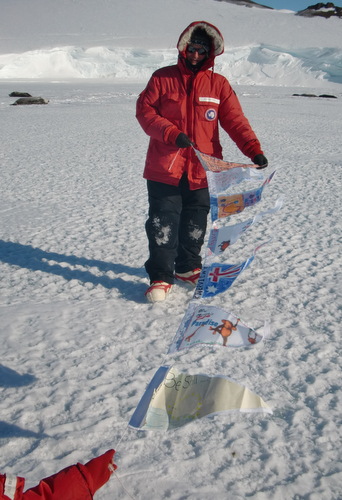
- Ms. Lake at SS Peter and Paul School in Nauvoo, Illinois
- Mitchell Community Center
- Riverview Community Center
- North Frayser Tigers Community Center
- Gaisman Community Center
- Kate Sexton Community Center
- Orange Mound Community Center
Weddell Seal’s Blubber
How do I measure up?
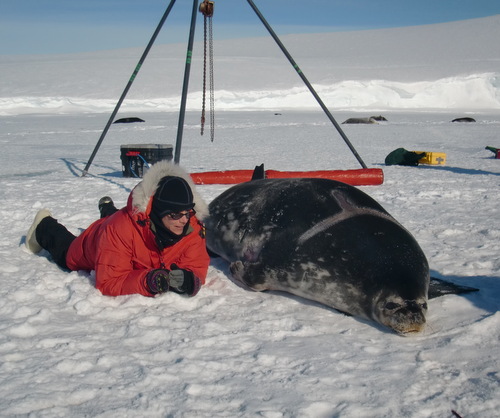
I’m sure you’ve noticed how HUGE these Weddell seals are! Check out the picture above… Look how small I am, compared to the Weddell seal! Not sure how much I weigh with all of these clothes on, but these seals typically weigh anywhere from 500-1,150 pounds. And a big chunk of that is blubber. Blubber is a special layer of fat, and it makes up about 20-40% of a Weddell seal’s body.
In humans, too much fat can be a bad thing, but in Weddell seals, bigger is often better – within reason, of course. That’s because blubber plays a very important role for the Weddell seals.
Can you guess what it is?
Insulation
Yep, insulation! Blubber is what keeps the seals warm! It is an internal insulator, protecting their bodies from the cold and keeping their internal temperature around 100° F. That’s pretty close to our body temperature, which averages around 98.6° F. Sometimes, they get so warm that they will melt the ice around them when they are hauled out!
Check out the imprint that a Weddell left in the ice!

How much blubber do they have?
Well, it depends on the time of year! Between October and January (which is spring and summer in Antarctica), they are mating, pupping and molting. During this time, they spend a lot less time diving and foraging for food, so they lose some of this fat reserve. By the end of the summer, they are at their thinnest and are ready to start actively foraging to build up their fat and energy supply. And that’s what they are doing from February to September – fattening up! During the Antarctic fall and winter, they can have more than 2 inches of blubber under their skin. That can be up to 240 kilograms or 528 pounds of pure blubber!
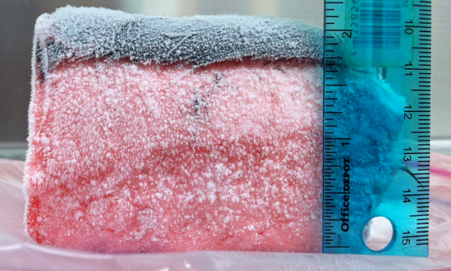
Blubber = Energy
Keeping the Weddell seals warm isn’t blubber’s only job. They can break down their blubber layer to create energy when they really need it. That’s generally when they are hauled out on the ice, instead of hunting for food. But when the seals are hauled out, they aren’t just hanging out!
OK, they do spend a good bit of time resting, but this is the time of year when seals are pupping, breeding and molting. All of which require energy! Females especially use a lot of energy during the pupping season. It takes quite a bit of energy to care for their pups. Most of the energy they use goes to producing their calorie rich milk. Their milk is made up of 54% fat, and that fat comes directly from their store of blubber.
Pups are not born with much blubber. They have to quickly make their own, using fats from the milk that they get from their mom. The moms lose about 100 kilograms or 220 pounds of their own blubber while nursing their pups. That’s about 5 pounds of blubber per day. Wow!
Difference in size
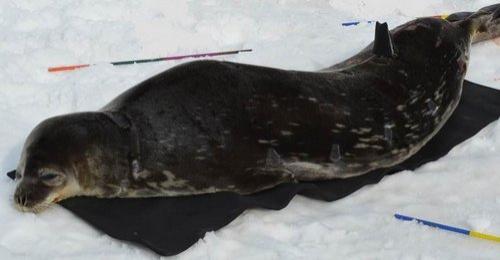

So, why are some seals smaller than others? Some of the seals we examine are nice and fat, but others are much smaller. The skinnier seals we’ve worked with have been feeding their pups, essentially transferring their blubber to the pups. These moms lose about 30% of their body mass to their pups. The fatter seals are usually the skip breeders. They haven’t pupped, so they haven’t had to use their blubber reserve. The new moms, however, will have to go on several foraging trips to build up that blubber layer again. Surprisingly, these new moms can gain up to one kilogram per day and can gain about 212 pounds in only two months!
How does this help our research?
Our research team is very interested in blubber, and we’ve been taking a lot of blubber samples!
What do you think we can learn from the blubber?
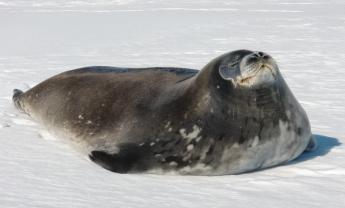
Have you ever heard the expression ‘you are what you eat?’ That expression holds true for Weddell seals, too. The Weddell’s blubber is made up of the fats that they eat. By analyzing their blubber, we can learn more about what the seals are eating. One of the big questions our research team is asking is, which fish do Weddell seals eat more: Antarctic cod or Antarctic silverfish? These two fish differ in the fats they have, and so seals eating more of one species should have different fats in their blubber. Hopefully, these blubber samples can give us some clues!
Not only are we taking blubber samples, but we are also measuring blubber thickness and fatness, while the moms are nursing their pups. We can measure the blubber thickness using an ultrasound machine (below, left). When we put the ultrasound probe against the fur of the seal, the ultrasound machine shows us the skin layer (below, right) and the fascia, which is the part where the blubber layer and the muscle layer meet. By measuring the distance from the skin to that layer, we can figure out how deep the blubber is (red arrow).
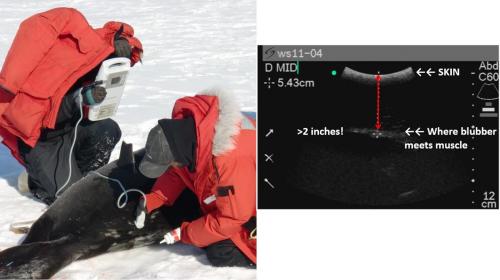
Then about 2 months later, during the molt, we will measure the blubber again and see how it has changed. As you can see, the amount of blubber the seals have tells us a lot about what they have been doing. If the seals have been diving and feeding on lots of fish, they will be much fatter than the ones who have been resting or nursing on the ice.
But there is one thing about blubber that doesn’t seem to add up: why are some Weddell seals skipping their breeding cycle? These seals are nice and fat, so it is not a lack of energy!
We are hoping to get to the bottom of some of these questions during this field season. But, as is usual with science, sometimes those answers can lead to more questions. But that is what makes scientific research so exciting!


Comments